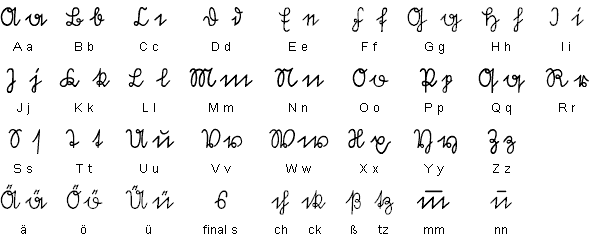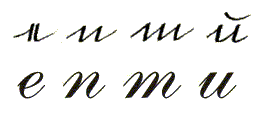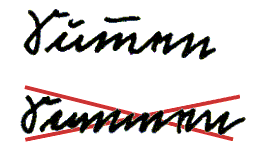
Viewing the signatures of our Mumma ancestors is instructive because their signatures suggest whether they could read or write documents in German, English or could not even write their names. Often old Wills or deeds filed in courthouses and transcribed into the county records will note whether the person signed the original document "in German". If you are very lucky, the original Wills are still found among the estate papers.
To understand these German signatures, one needs to understand the old German script that was used in the early days of the German speaking people of Europe. This style was commonly used in old church registers or in written documents and it has several unusual characters found only when handwritten and not in the printed language. One is the letter "u". In the handwritten language, the lower case "u" has a mark placed over the top of the "u" which is slightly curved mark. This special mark is some times called a "U-Bogen". Bogen in German means an "upward curved line". I have also heard it called a crecent. Its purpose is to insure that the "u" is not mistaken for an "n" or "m", especially when a "u" is followed by an "m" or "n". This mark should be thought of as a part of the "u", not much different than a dot placed over the letter "i" or "j". Transcribers often confuse this symbol for a German diacritical mark called an umlaut which has two dots placed over the "u". Two other characters that are often seen in the handwritten language is a shorthand notation used when a double "mm" or "nn" are encountered. In this case, the "m" or "n" are only written once, but a line is placed over the top. This helps distinguish the characters. Because this shorthand notation is not found in the English language, the bar was often not copied and the letters not doubled by English clerks, hence just the single "m" or "n" remained. This is an obvious reason the spelling of MUMMA was often inadvertently shortened to MUMA. A chart showing the various letters used in handwritten Sütterlin is shown below. If you compare the lower case "u", "m" & "n" you can see how easily it is to confuse which letters are which, especially when three of them are adjacent to each other as in the Mumma surname.

The following is found on the German Genealogy web site [http://www.tr62.de/script/letter3.html].

One problem of old German handwriting is that some letters look quite similar. The example on the left is in one's best handwriting. Even then it is difficult to make out if it is "u" or "n". Therefore, the "u" has to be written with a bent horizontal line. The "e" is much more narrower than "n", but be aware the writers in earlier times did not use always their best handwriting.

On the right side you can see the word "Summen" (sums). You can see what happened when these similar letters are written in one word. The bend line on the "u" is sometimes really helpful. The straight line on the "m" stands for a double "m". You can find such a strait line also on top of an "n" if the word has to be written with a double "n". With these two lines - bent on "u" and strait on double "m" and "n" - it is a bit easier to read a word.
[this information is from the Walden Font Company web site http://www.waldenfont.com/typecase.asp?productid=2&fontid=15]
There is currently much discussion as to the origin and development of the Old German script. There are as many different opinions as there are voices talking about it. To avoid further confusion and clear up the record, we would like to trace the origins and development of the Old German Script from its beginnings in the first half of the 16th century to its termination as the “standard” German script in 1941.
The Kurrent script, which is commonly known as “The Old German Script” evolved from the gothic cursive handwriting at the beginning of the 16th century. The gothic cursive had been in use throughout much of the medieval ages and had developed into a staggering number of different writing styles. The need for a uniform and legible handwriting led many important writing masters to the development of the Kurrent, a script that was soon adopted by many chancelleries because it was beautiful, fast to write and comparatively legible. This initiated the widespread use of Kurrent as an everyday handwriting.
Over the next two hundred years, writing styles became more and more standardized, so that by the end of the 18th century the “modern” form of the Kurrent was established.
Anybody who has tried will confirm that the classic Kurrent script is very hard to write. There are many sharp angles, straight lines and abrupt changes in direction. To give schoolchildren an easier start on the art of writing, the Viennese graphic artist Ludwig Sütterlin (born 1865, died 1917) devised a form of Kurrent that consisted of wide curves and very few sharp angles. He intended it as a basic script on which pupils would develop their individual handwriting. This Kurrent was accepted as standard script in all Prussian schools in 1915. By 1934, it was firmly established at virtually all German schools. Sütterlin Kurrent is the handwriting remembered by the older German generation. Like all Fraktur and Kurrent types, it mostly disappeared after 1941.
After the turn of the century, Kurrent, much like its printed counterpart Fraktur, declined in popularity. As German society became more cosmopolitan, it viewed the national style of writing as antiquated and ugly. Consequently, the humanist Antiqua, both in its printed and written form became more and more fashionable. This, of course, changed with the rise of the Nazi regime.
Antiqua and Latin script were declared “Un-German” and “non-Aryan.” Only Fraktur and Gothic typefaces were to be considered “German.” As a result of this policy many bastardized Gothic and Fraktur designs cropped up, all of them commonly known as “Schaftstiefel Grotesk.” (Jack-boot Helvetica)
In 1941 however, Hitler ordered a complete reversal of existing policy and issued a curious decree, declaring Fraktur and Kurrent to be of “Jewish origin” and therefore taboo.
The motive for this sudden change is easily seen. The German administration of the occupied countries had found that Fraktur and German script formed a veritable communication barrier with the peoples of Poland, France, The Netherlands, Belgium, Yugoslavia, Greece and parts of the Soviet Union. German or not, it had to go.
The nazi propaganda machine was charged with building public support for the decision, but quite apparently it choked on this particular bit of nazi reasoning. No mention of the order is made in the official newspapers for the following six months. At the start of the new school year, a more plausible reason was found, and the Reichsminister for Education touted the new policy as the creation of new standard script, better suited as a base for an individual handwriting. The Völkischer Beobachter (the official Nazi party newspaper) chimed in, complaining that presently German children had to learn eight different alphabets (Fraktur, Kurrent, Antiqua and Latin Script, upper and lower case each), which would now be reduced to four, thus making learning much easier on the children. The result, in any case, was that Kurrent was no longer taught in schools.
It is a misconception that the allied forces officially prohibited the use of Fraktur and Script. It is, however, conceivable that local commanders preferred to have communications printed in Antiqua — again because non-Germans could not read Fraktur and Kurrent. (Ewig-Gestrige die jetzt “Alles Lüge” schreien - bitte hier klicken)
Not quite. Some German schools still taught the Old German Script in optional afternoon classes. I still have a primer entitled “Wer kann das lesen,” printed in 1954, which is indicative of the innocence that was commonly felt about the way Germany wrote. The poor image of Fraktur and Kurrent only came about when movies, television and printed media associated Fraktur with the Third Reich - to the extent that for some time any blackletter font was considered “Nazi Type.”
We hope to have made a contribution to restore - or at least patch up - the image of Kurrent and Fraktur. Please feel free to send any comments or questions to oliver@waldenfont.com
Between 1727 and 1776, all male German immigrants over the age of 16, who landed in Philadelphia, were required, if not too sick, to go to the courthouse and sign two oaths. The first oath was the Oath of Abjuration to renounce all previous allegiances and the second oath was an Oath of Allegiance to the King of England and the Colonial government of Pennsylvania. Two different clerks helped with the signing. If an immigrant could not sign his name, then the clerk would sign the immigrant's name and the immigrant would make his mark, whether it be an X or some other unique character. These Mumma signatures were scanned from book, "Pennsylvania German Pioneers", by Strassburger and Hinke. The first group of signitures are those of the Mumma immigrants when they landed in Philadelphia and were required to sign the various oaths. the signatures that follow have been extracted and copied from various Wills, deeds and other documents. Some of the most interesting signatures are those near the bottom where the u-bogen and the bar-m are used together. This is a very rare way to write the name, but it is correct.
![Signatures of Jacob Mumma [1]](../databases/photos/JacobListB.jpg)
![Signatures of Jacob Mumma [1]](../databases/photos/JacobListC.jpg)
Signatures of [1] Jacob Mumma on Immigrant lists B & C on 11 Sept. 1731
![Signatures of Lenhart (Leonard) Mumma [2]](../databases/photos/LeonardListB.jpg)
![Signatures of Lenhart (Leonard) Mumma [2]](../databases/photos/LeonardListC.jpg)
Signatures of [2] Lenhart (Leonard) Mumma on Immigrant lists B & C on 18 Sept. 1732
![Signatures of Johann Lorantz Momma [3]](../databases/photos/LorantzListC.jpg)
![Signatures of Johann Lorantz Momma [3]](../databases/photos/LorantzListB.jpg)
Signatures of [3] Johann Lorentz Momma on Immigrant lists B & C on 13 Oct. 1747
![Mark of Peter Mumma [4]](../databases/photos/PeterListC.jpg)
The "mark" of [4] Peter Mumma on Immigrant list C on 16 Sept. 1748. A clerk
wrote his name for him.

Signature of [13] Frederick Mumma (~1730-1814) on the final accounting of his son, Chistian Mumma's estate - 1797

Mark of [21] George Anthony Mumma (~1795-1786) on his Will dated 1785

Signiture of [251] Johannes "John" Mumma (1750-1839) on a deed dated 1811

Signature of [2514] Johannes "John" Mumma (1780-1849) on a deed dated 1838

Signatue of [U30-1] John Mumma (~1755-1823) on a deed dated 1804

Signature of [U30-111] John Mumma, Esq. (1798-1826} on estate papers filed 1825
Return to the MUMMA Archives. web site
Return to the Mumma-Moomaw Surname Page
[Copyright (C) 2004 by Douglas M. Mumma. All rights reserved]
27 Aug 2015, 11:48:09